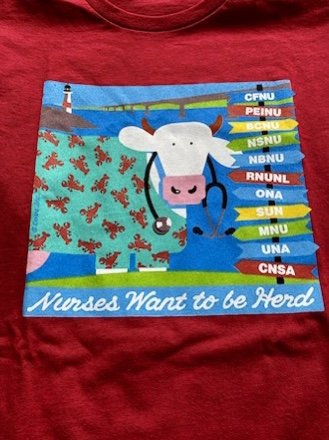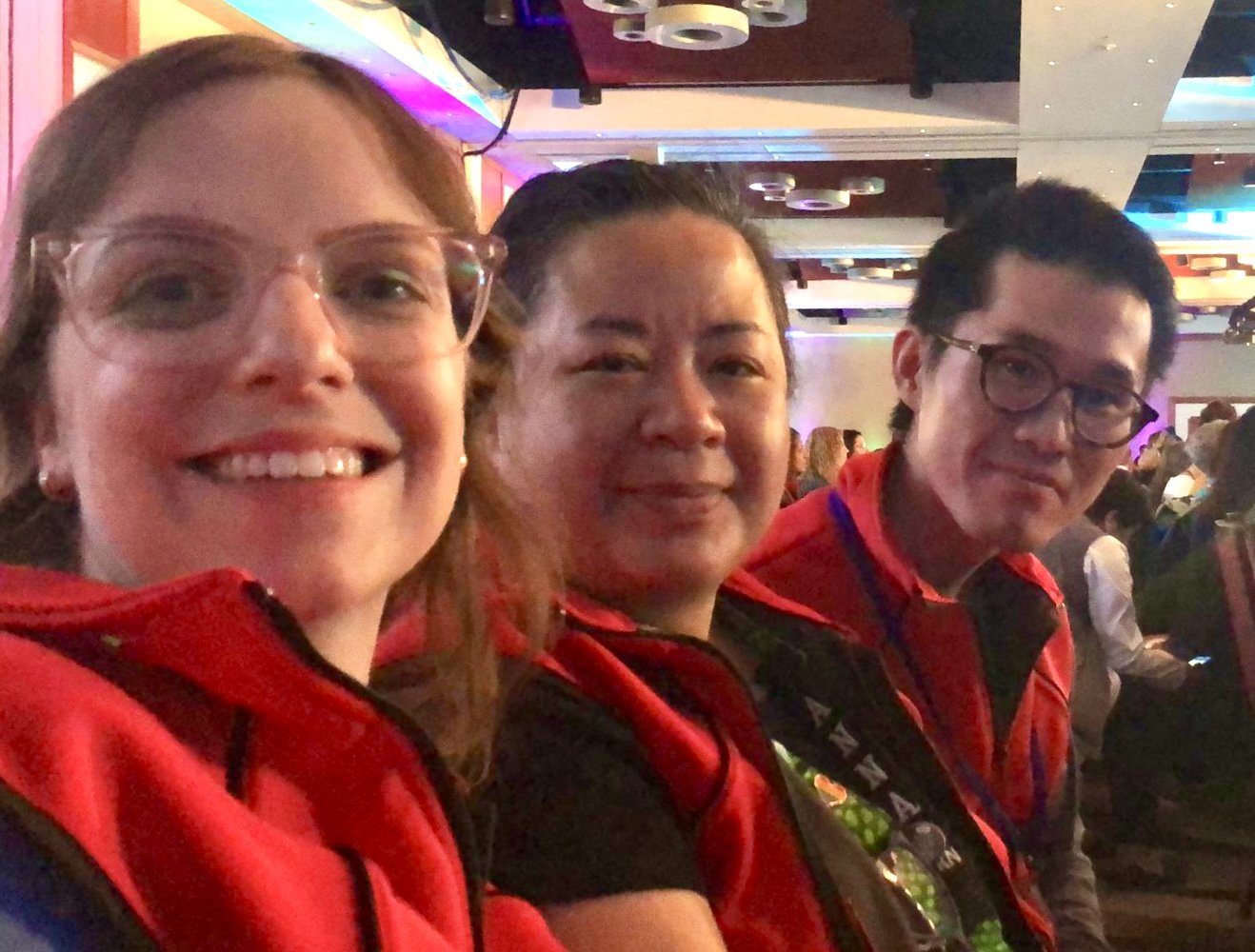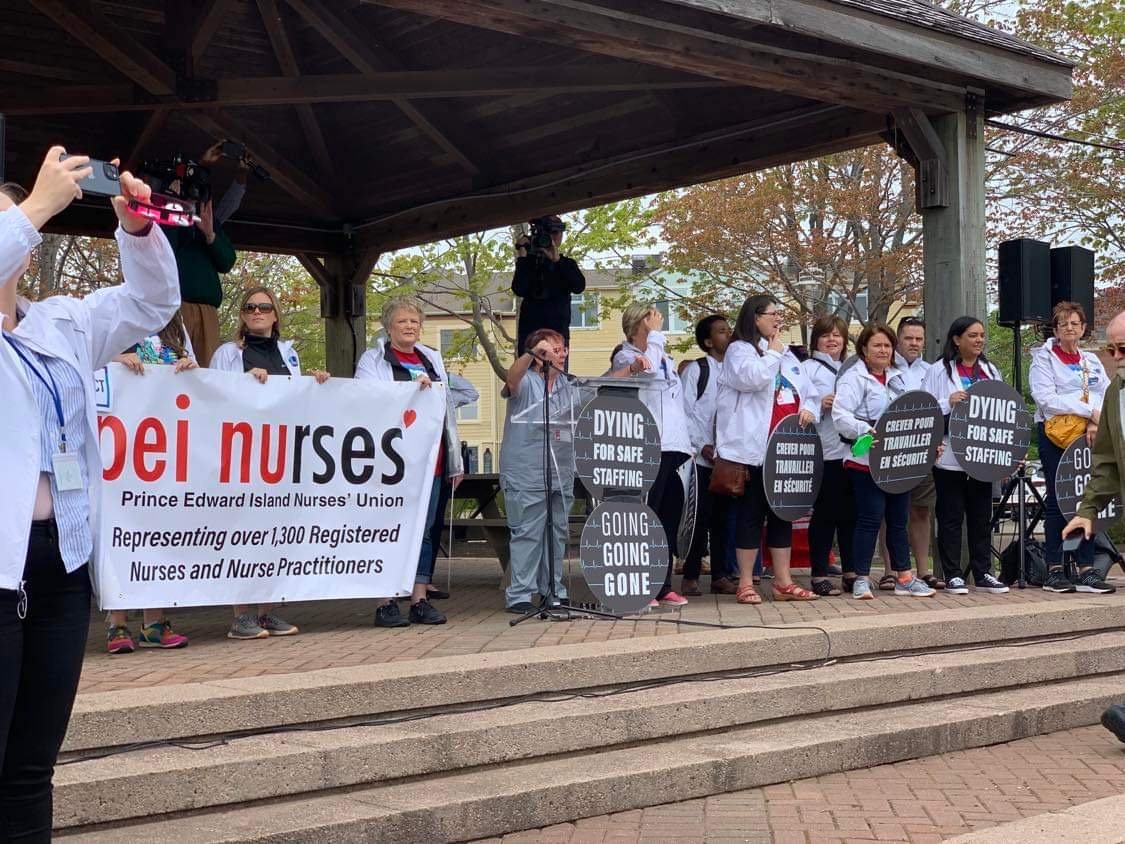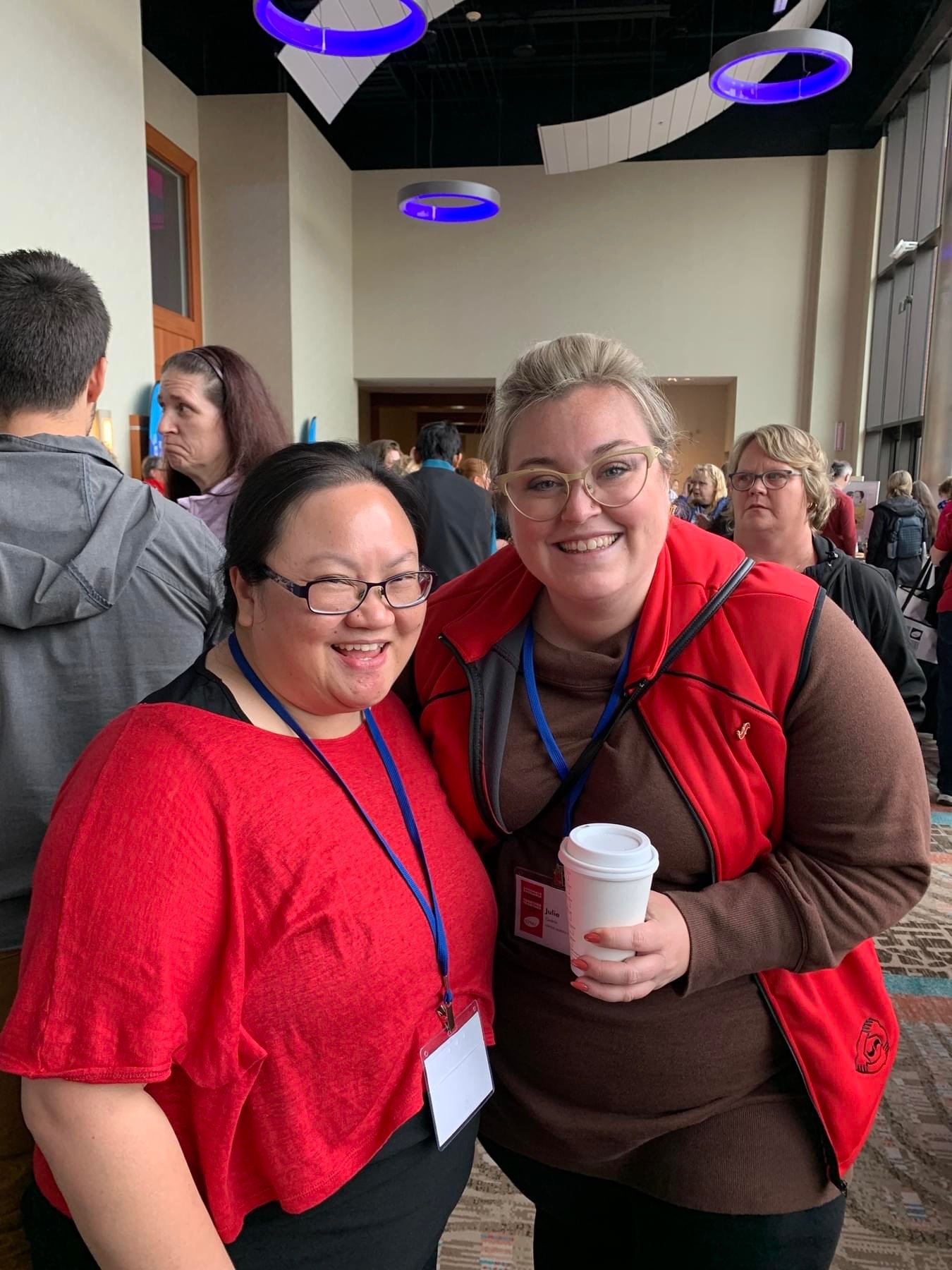A new @CIHI_ICIS report gives a glance into rates of overtime, sick time, private agency nurse hours, and unintentional patient harm in Canada’s hospital inpatient units. One thing is clear: to protect patient safety, we need to better retain nurses.
New report highlights pan-Canadian need for safe staffing to protect patient safety →
CFNU President - Linda Silas
“You are not angels of mercy. You are hard working professional nurses and you deserve respect!” was CFNU President Linda Silas' message to the more than 1000 people attending UNA's AGM in Edmonton today.
Retaining Nurses
Parkland Conference →
The @ParklandInst's “At the Crossroads” conference on November 17-19 is a space where we can learn from each other and begin shaping the Alberta we want for us and for future generations.
40% of nurses are looking for the exit sign →
Planning session to fight the proposal for an Alberta Pension Plan
The CDLC invites you to join us Tuesday, October 3, 2023 at 7 pm
For a planning session to fight the proposal for an Alberta Pension Plan
Click link to join Zoom Meeting:
https://us02web.zoom.us/j/84879918496?pwd=REdLNEFFekZtMUxuR1Z6aHZkUGp1UT09
Meeting ID: 848 7991 8496 Passcode: 445331
Meet the MLA's
Meet the MLA's
Read more📢CALLING ALL NURSES📢
📢CALLING ALL NURSES📢
Read moreCDLC Food Drive
If people go in person on Monday Sept 4th, you get entered into draws for a Nintendo switch, I watch and pizza oven!
Follow link for details!
https://bit.ly/47QPvX1
CDLC Labour Day Free Dray
CDLC Labour Day Free Dray
Read moreLabour Day Fill The Van Food Drive
Labour Day Fill The Van Food Drive
Read morePics from the CFNU Biennial Convention in PEI
Pics from the CFNU Biennial Convention in PEI
Read moreUNA awards 15 nursing education scholarships plus one CFNU scholarship
UNA awards 15 nursing education scholarships plus one CFNU scholarship
Read moreAARN
Check your in-box to see if you’ve been asked to take part in CFNU’s survey →
Apply for the International Solidarity Fund →
The CDLC S'ean Gillen Memorial Scholarships
Calgary & District Labour Council S'ean Gillen Memorial Scholarship
Terms of Reference
Value: Two (2) $2500 scholarships to be awarded annually.
Eligibility:
Awarded to affiliated members of the CDLC, their spouses, or dependents, whose union local is
in good standing.
These scholarships are available for education or training from a recognized educational
institution. (Public postsecondary institutions given authority to grant degrees, diplomas, and
certificates through specific legislation are “recognized” institutions. A small number of private
postsecondary institutions also have been given degree-granting authority, and these too are
“recognized.”)
Criteria:
The person applying (or their family member), must be a dues-paying member of a union local
that is affiliated to the Calgary & District Labour Council, and work in the Calgary district (as
defined in the CDLC by-laws).
For the duration of the COVID-19 Pandemic the CDLC will be accepting applications from union
members or their families who have been temporarily laid off.
How to Apply:
Fill out the scholarship application form and the questionnaire, and submit to the office of the
Calgary & District Labour Council by mail to #321, 3132 - 26 St. NE Calgary, AB T1Y 6Z1, or by
email to admin@thecdlc.ca.
Deadline:
Must be received by June 1st. The scholarship recipients will be notified by September 1st.
Applicants are required to submit a completed questionnaire. (see below)
Decisions of the CDLC Scholarship Committee will be final. The scholarship committee will be comprised
of the CDLC President, one member of the CDLC Executive, and one delegate to the CDLC.
The CDLC will remit monies directly to the successful recipient, upon the provision of their documentation
indicating the course(s) for which they have registered.
Previous recipients of a CDLC's Sean Gillen Memorial Scholarship must wait two years before they can
apply again.
DLC S’ean Gillen Memorial Scholarship Questionnaire
Answer only one of the three questions provided.
Answers may be presented in point format.
May be presented on a separate sheet than this one.
1. Why are unions important to me? (maximum 250 words)
2. What have unions done to improve the lives of workers? (maximum (250 words)
3. What are recent examples of union successes in Alberta? (maximum 250 words)
COVID-19 Variants of Concern and Canada’s Immunization Efforts
Fact Sheet
February 18, 2021
Summary: A number of new COVID-19 variants of concern have recently been identified in Canada during 2021, leading to concerns about increased transmissibility, potentially worsened disease severity and resistance to existing vaccines.
How immunity after vaccination works: The immunity to the coronavirus we develop following vaccination or infection is largely due to the development of antibodies that bind to the receptor binding domain (RBD).1
How the current vaccines (Pfizer-BioNTech and Moderna) approved in Canada work to protect people: Pfizer-BioNTech and Moderna are both mRNA vaccines. mRNA vaccines work by introducing an mRNA sequence (the molecule which tells cells what to build) which is coded for a disease-specific antigen; once produced within the body, the antigen is recognised by the immune system, preparing it to fight the real thing.
Mutations of concern in new variants
N501Y: Using the spike protein is how the coronavirus enters cells, and N501Y is in an especially important region called the receptor-binding domain, which latches on to the cell. An N501Y mutation may make the spike protein stickier, allowing it to bind to and enter cells more readily.
D614G: The D614G strain of coronavirus dominates because it increases the spike protein’s ability to open cells for the virus to enter. The D614G mutation causes a flap on the tip of one spike to pop open, allowing the virus to infect cells more efficiently.
E484K escape mutation: Mutations in the spike domain of the virus can allow the virus to evade or partially evade these antibodies. This is the reason they are called “escape mutations”.
Current status: 570 cases of variants have been confirmed in Canada (February 17, 2021).
1 Receptor-binding domain (RBD) is a key part of a virus located on its spike domain that allows the virus to dock to body receptors and gain entry into cells, leading to infection.
B117 (UK/Kent variant)
• First detected in September 2020 in Greater London UK region.
• First detected in December in Ontario; now found in all Canadian provinces, most in Ontario; 300 cases in Newfoundland and Labrador have been associated with this variant. Community spread of B117 has been confirmed in at least four provinces. It is predicted to become the dominant variant sometime in March.
• Transmissibility rate: averages 50% (CDC)
• Why it spreads
o One analysis found that more than a third of patients infected by B117 had high viral loads. o N501Y: Because of the N501Y mutation, B117 strain may also be ‘stickier’, or better able to grab onto the cells that it infects.
o D614G: Allows B117 to enter cells more effectively, giving it the ability to spread more quickly than the original predominant virus.
• Risk of severe illness: In January 2021, scientists from the UK reported evidence that suggests the B117 variant may be associated with an increased risk of death, compared with other variants. According to UK researchers, it is estimated to be 30% more fatal.
• Vaccine efficacy: Because B117 and the most prevalent strain share 99% of the same proteins, it is likely that both the Moderna and Pfizer-BioNTech vaccines will still be effective against the variant.
B117 with E484K mutation
• On February 1, 2021, scientists in the United Kingdom reported that a small number of B117 variants have developed the E484K mutation thought to help SARS-CoV-2 partly evade immunity.
501Y.V2, or B.1.351 (South African variant)
• First detected in October 2020 in Nelson Mandela Bay, South Africa
• Detected first in Alberta in January 2021, now in Ontario, Quebec and British Columbia • Based on the UK variant
• Transmissibility rate: 50%
• Why it spreads
o N501Y: Because of the N501Y mutation, the strain may also be ‘stickier’, or better able to grab onto the cells that it infects.
o D614G: Allows B.1.351 to enter cells more effectively, giving it the ability to spread more quickly than the original predominant virus.
• Risk of severe illness: Currently there is no evidence to suggest that this variant has any impact on disease severity.
• Vaccine efficacy:
o This variant has multiple mutations in the spike protein, including the escape mutation E484K.
o A laboratory study suggests that the South African variant of the coronavirus may reduce antibody protection from the Pfizer/BioNTech vaccine by two -thirds, and it is not clear if the shot will be effective against the mutation, the companies have said. The study found the vaccine was still able to neutralise the virus, and there is not yet evidence from trials in people that the variant reduces vaccine protection, particularly against severe illness. The company is making investments and talking to regulators about developing an updated version of their mRNA vaccine, or a booster shot, if needed.
P.1 (Brazilian variant)
• First identified in January 2021 in travelers from Brazil who arrived in Japan • Detected in Ontario only (one case)
• Based on the UK variant
• Transmissibility rate: unknown
• Why it spreads
o N501Y: Because of the N501Y mutation may also be ‘stickier’, or better able to grab onto the cells that it infects.
o D614G: Allows P.1 to enter cells more effectively, giving it the ability to spread more quickly than the original predominant virus.
• Risk of severe illness: Currently there is no evidence to suggest that this variant has any impact on disease severity.
• Vaccine efficacy: unknown
o The P.1 variant has 17 unique mutations, including three in the receptor-binding domain of the spike protein, and including the escape mutation E484K.
B1525 (Nigerian variant)
• 1 case found in British Columbia
• Includes the escape mutation E484K
Will the existing vaccines work? Evidence suggests that the available COVID-19 vaccines may still produce protective immune response against the new variants identified even when the escape mutation is present. Changes to the vaccine can be made to target novel variants and will likely be needed as new variants will begin to become dominant amongst the viruses that are circulating.
Strategies have been devised to overcome a potential decrease in vaccine efficacy: • The vaccine administration regimen can be modified to increase the overall immune response and, ideally, provide more protection against new variants (e.g., an additional booster vaccine dose can be considered).
• Optimisation of the original vaccine, such as the development of a new version with an updated spike protein, is also possible.
• To determine whether either of these approaches are required, surveillance data on emerging variants are being collected to ensure that the best vaccine strategy is being employed. • As new variants continue to spread, it is more important than ever that existing public health measures – masking, physical distancing, hand washing, cleaning protocols and ventilation – be maintained and even potentially enhanced, even as the vaccine rollout continues across Canada.
References
Zhang, Z. (2021, January 18). The Atlantic.
https://www.theatlantic.com/health/archive/2021/01/coronavirus-evolving-same-mutations-around world/617721/
CDC:
• https://www.cdc.gov/coronavirus/2019-ncov/more/science-and-research/scientific-brief emerging-variants.html
• https://www.cdc.gov/coronavirus/2019-ncov/cases-updates/variant-surveillance/variant info.html
Zimmer, K. (2021, January 26). The Scientist Magazine. A Guide to Emerging SARS-CoV-2 Variants | The Scientist Magazine® (the-scientist.com)
Technology Networks. (2020, November 13). Genomics Research from Technology. https://www.technologynetworks.com/genomics/news/what-the-d614g-mutation-means-for-sars-cov 2-vaccines-342786
Duong, D. (2021, January 25). CMAJ. https://www.cmaj.ca/content/193/4/E141
Astrazeneca:
https://www.astrazeneca.com/what-science-can-do/topics/disease-understanding/the-natural evolution-of-sars-cov-2.html
Calgary & District Labour Council S'ean Gillen Memorial Scholarship
Terms of Reference
Value: Two (2) $2500 scholarships to be awarded annually.
Eligibility:
Awarded to affiliated members of the CDLC, their spouses, or dependents, whose union local is
in good standing.
These scholarships are available for education or training from a recognized educational
institution. (Public postsecondary institutions given authority to grant degrees, diplomas, and
certificates through specific legislation are “recognized” institutions. A small number of private
postsecondary institutions also have been given degree-granting authority, and these too are
“recognized.”)
Criteria:
The person applying (or their family member), must be a dues-paying member of a union local
that is affiliated to the Calgary & District Labour Council, and work in the Calgary district (as
defined in the CDLC by-laws).
For the duration of the COVID-19 Pandemic the CDLC will be accepting applications from union
members or their families who have been temporarily laid off.
How to Apply:
Fill out the scholarship application form and the questionnaire, and submit to the office of the
Calgary & District Labour Council by mail to #321, 3132 - 26 St. NE Calgary, AB T1Y 6Z1, or by
email to admin@thecdlc.ca.
Deadline:
Must be received by June 1st. The scholarship recipients will be notified by September 1st.
Applicants are required to submit a completed questionnaire. (see below)
Decisions of the CDLC Scholarship Committee will be final. The scholarship committee will be comprised
of the CDLC President, one member of the CDLC Executive, and one delegate to the CDLC.
The CDLC will remit monies directly to the successful recipient, upon the provision of their documentation
indicating the course(s) for which they have registered.
Previous recipients of a CDLC's Sean Gillen Memorial Scholarship must wait two years before they can
apply again.
DLC S’ean Gillen Memorial Scholarship Questionnaire
Answer only one of the three questions provided.
Answers may be presented in point format.
May be presented on a separate sheet than this one.
1. Why are unions important to me? (maximum 250 words)
2. What have unions done to improve the lives of workers? (maximum (250 words)
3. What are recent examples of union successes in Alberta? (maximum 250 words)


































































